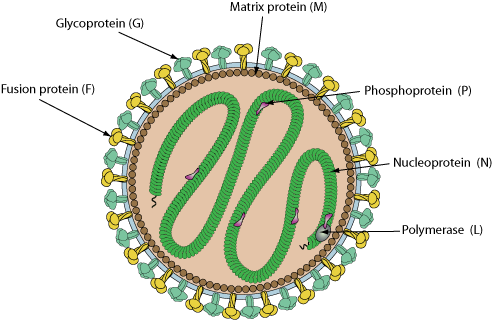Henipavirus (taxid:260964)
VIRION

Enveloped, spherical. Diameter from about 150nm.
GENOME
Negative-stranded RNA linear genome, about 18 kb in size. Encodes for nine proteins.
GENE EXPRESSION
The viral RNA dependent RNA polymerase binds the encapsidated genome at the leader region, then sequentially transcribes each genes by recognizing start and stop signals flanking viral genes. mRNAs are capped and polyadenylated by the L protein during synthesis. The V protein is produced through RNA editing and the C protein is produced by Leaky scanning of The P mRNA.
ENZYMES
- RNA-dependent RNA polymerase L
- Mononega-type capping
- RNA TPase, GTase, N7 Mtase, 2'O Mtase L
REPLICATION
CYTOPLASMIC
- Virus attaches to host cell surface receptors through G glycoprotein.
- Fusion with the plasma membrane; ribonucleocapsid is released in the cytoplasm.
- Sequential transcription, viral mRNAs are capped and polyadenylated in the cytoplasm.
- Replication presumably starts when enough nucleoprotein is present to encapsidate neo-synthetized antigenomes and genomes.
- the ribonucleocapsid interacts with the matrix protein under the plasma membrane and buds via the ESCRT complex, releasing the virion.
Host-virus interaction
Inhibition of host Interferon induction
The V protein plays a role in inhibition of MDA-5 antiviral signaling 
The P,V and W proteins play a role in inhibition of STAT1 antiviral signaling 
Matching UniProtKB/Swiss-Prot entries
(all links/actions below point to uniprot.org website)18 entries grouped by protein
2 entries
Protein C
2 entries
Fusion glycoprotein F0 (Protein F)
2 entries
Glycoprotein G
2 entries
RNA-directed RNA polymerase L (Protein L) (Large structural protein) (Replicase) (Transcriptase)
2 entries
Matrix protein (Protein M)
2 entries
Nucleoprotein (Protein N) (Nucleocapsid protein)
2 entries
Phosphoprotein (Protein P)
2 entries
Non-structural protein V
2 entries
